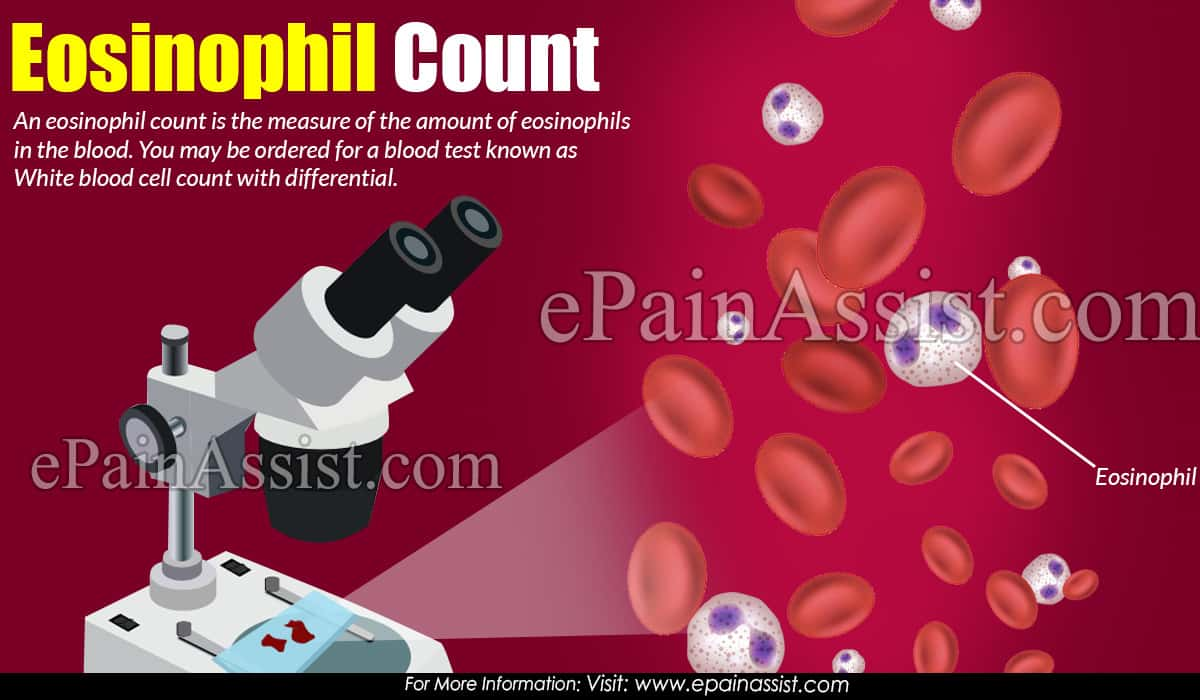A Brief Note On Eosinophils:
Our body’s immune system make use of WBCs or white blood cells to fight off bacteria, viruses and other foreign particles that could cause infection and illnesses. However, it does not just use one WBC type to do it. Instead, there are several types of immune system cells; and these include eosinophils.
Eosinophils are made by the body in the bone marrow. They normally take a week to completely mature. Eosinophils play a vital role in the overall immunity of an individual. Adequate levels of eosinophils are required for the body to function normally and smoothly.
It must be mentioned that although eosinophils are part of immune system, some of their responses are not always healthy for the body. Sometimes these esinophils play a part in conditions like food allergies and inflammation in the tissues of the body.

Know-About Eosinophil Count:
An eosinophil count is the measure of the amount of eosinophils in the blood. You may be ordered for a blood test known as White blood cell count with differential. The “Differential” means that the laboratory will test not only how many WBCs are present in the body, but also how many of each kind of WBCs there are. The results of this test would measure eosinophils, basophils, lymphocytes, monocytes and neutrophils.
The doctor may also order a blood test as a complete blood cell count with differential, which measures WBCs and also the RBCs and other parts of the blood. It must be noted that the normal value for eosinophils may vary from laboratory to laboratory.
The normal range for eosinophils is between 0 and 450 per cubic millimeter of blood. However, in case of any illness or infection, this normal range may not be present; there may either be a high eosibophil count or a low eosinophil count. More about these are discussed in the following sections.
What Does It Mean When You Have High Eosinophil Count?
High levels of Eosinophils or high eosinophils counts in the blood is also known as Eosinophilia. This level ranges between 500 to 1500 per microliter of blood. A high eosinophils count may indicate a number of conditions, such as, allergies, asthma, inflammatory conditions like, Celiac disease or Inflammatory bowel disease, abnormal blood clells or Hypereosinophilic myeloid neoplasms, Eczema or dermatitis or other inflammatory skin conditions, parasitic infections, reactions to medications, or Cancerous growth including Hodgkin’s disease.
There may be a high level of eosinophils not only in the blood, but also in the body’s tissues. Because an underlying condition causes high eosinophils count, having high levels of eosinophols can cause several symptoms in a person. One must talk to doctor in such case and find out professional ways to treat eosinophilia.
What Does It Mean When You Have Low Eosinophils Count?
A low level of eosinophils or low eosinophils count is also known as Eosinopenia. It must be noted that a low level of eosinophils is not usually considered a medical problem. However, when one has a low eosinophils count, it means that there are some conditions that is causing the same. One condition would be drunkenness. Excessive alcohol intake or excessive production or cortisol, like Cushing’s disease can result in a low eosinophils count.
It must be noted here that low eosinophil count is a cause of concern only if there is a history of alcohol abuse in the patient or the patient has a known diagnosis of Cushing’s disease, unless of course the WBC counts are abnormally low in the patient. In case all white blood cell counts are low, this can signal a problem with the person’s bone marrow.
Conclusion:
So, we now know what it mean to have a high eosinophils count and a low eosinophils count. We must keep you informed that, eosinophil counts are lowest in the morning and are highest in the evening. If you experience any symptoms that might be due to an anbnormal range of eosinophils count, especially a high eosinophils count, then do talk to your doctor and get yourself properly diagnosed and treated as soon as possible.
